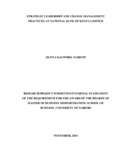| dc.description.abstract | This study sought to examine whether the interactions on new media could be meaningful to commercial institutions. The main objective of the study was to evaluate the role of KCB‟s Twitter platform in enhancing the organization‟s collective intelligence. The specific objectives of the study were to; understand the characteristics of Twitter users following KCB; determine how KCB social media management team utilizes the tweets and lastly to establish whether customers‟ tweets have influenced organizational decision making in relation to product intelligence. This study adopted a pluralism theoretical approach. Pluralism conceives of the media as reflecting the diversity of their audiences. Various groups in the population can make themselves heard at some crucial point of decision making. It contends that everybody has a voice and a choice and this supports the role of media in allowing peoples‟ views to be represented without favor. This theory was relevant for the study because Twitter gives power to individuals in a society to express themselves as they make policy proposals in connection to various aspects of their lives among them social, cultural, economic and political. The study was in form of a case study, with the focus on Kenya Commercial Bank (KCB Ltd). The target population was all members of KCB social media department. The social media department comprised of fourteen members. Two other staff were interviewed; a manager from Marketing department as well as a staff from the Money Transfer Services unit of KCB. KCB was selected because it is the oldest and largest bank in the country that also operated in all the Eastern Africa countries and had heavily invested in its IT structure.
This study used a qualitative approach to collect data. It adopted a descriptive approach as it sought to explain the what, where and how of the phenomenon. Data was collected through primary methods using both interviews and questionnaires. Interviews were administered to two members of social media department as well two key informants from Marketing and Money Transfer Departments of Kenya Commercial Bank; units involved in products innovation in the bank. Questionnaires were administered to ten staff of social media department. Data was analyzed qualitatively using a computer package, Excel. The qualitative data was analyzed by obtaining detailed information about the phenomena under study, then trying to establish patterns, trends and relationships from the information gathered. Finally, the data was presented using tables, graphs, pie charts, figures and narratives. The researcher found out that KCB used its Twitter handle not only as a customer service platform but also offered a forum through which customers aired their views concerning bank products. These views were channeled to relevant departments for various actions such as tailoring bank products to suit customer needs. Based on this study, it is suggested that further research be carried out on the role of new media in the other elements of market intelligence namely, competitor intelligence, customer understanding and market understanding. The researcher also recommends that a similar study be done on other financial institutions as the researcher limited her scope on Kenya Commercial Bank. Similarly, the researcher only focused on Twitter, and therefore recommends that further study be done to seek whether other social media tools such as Facebook and Watsup were used by commercial institutions for collective intelligence. | en_US |

